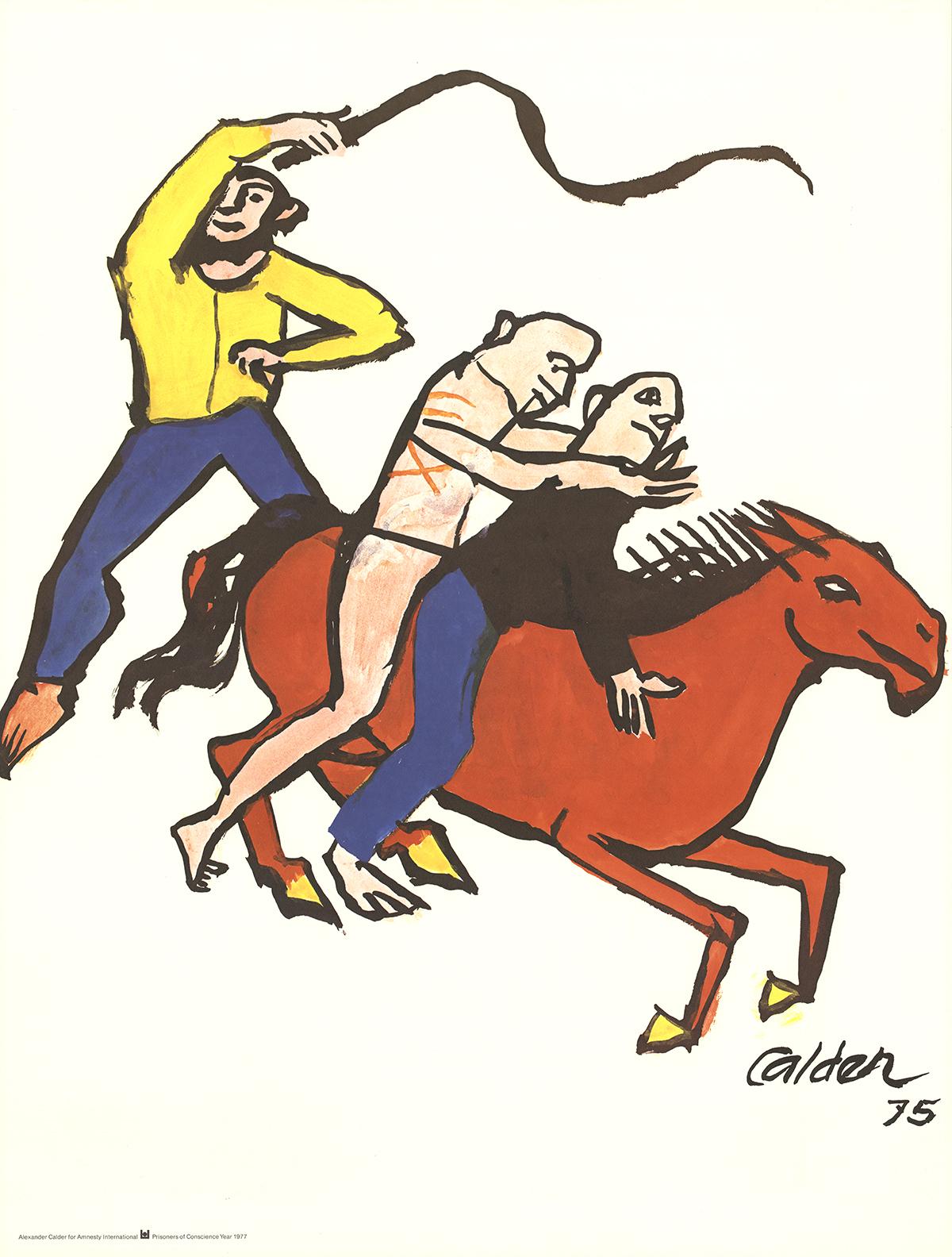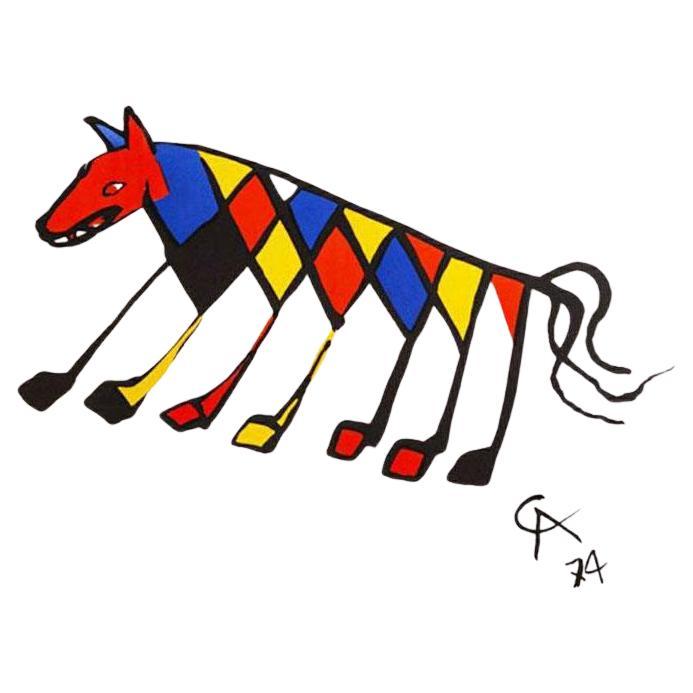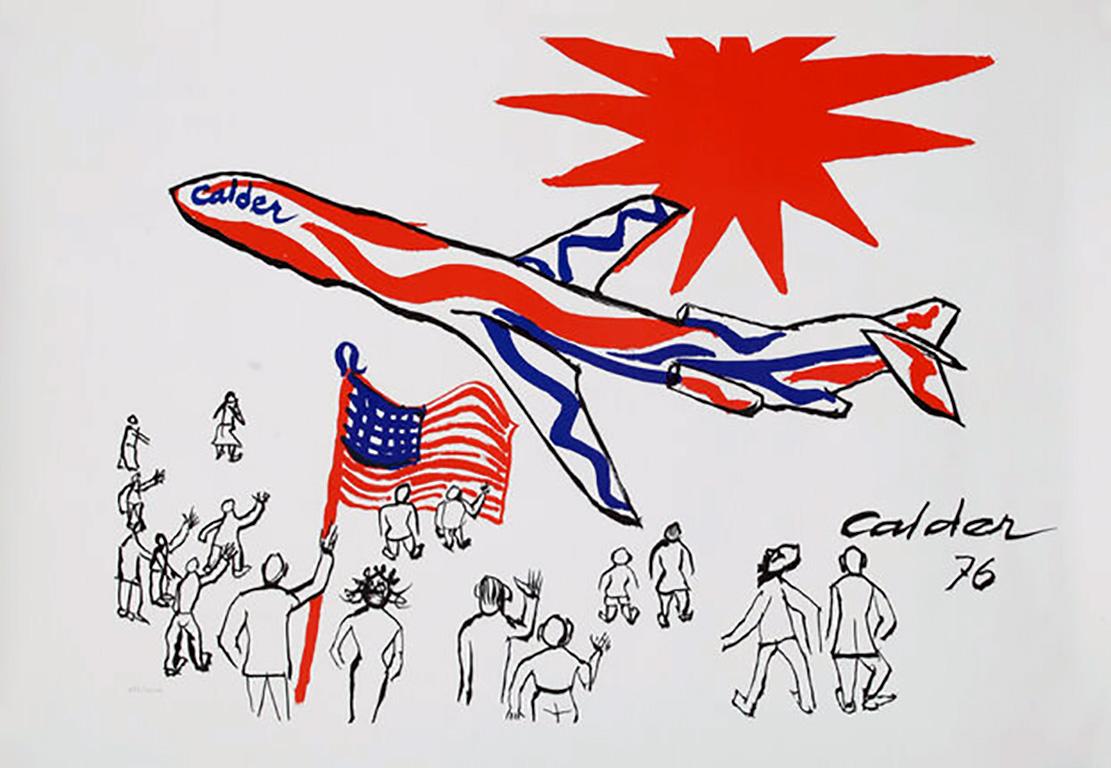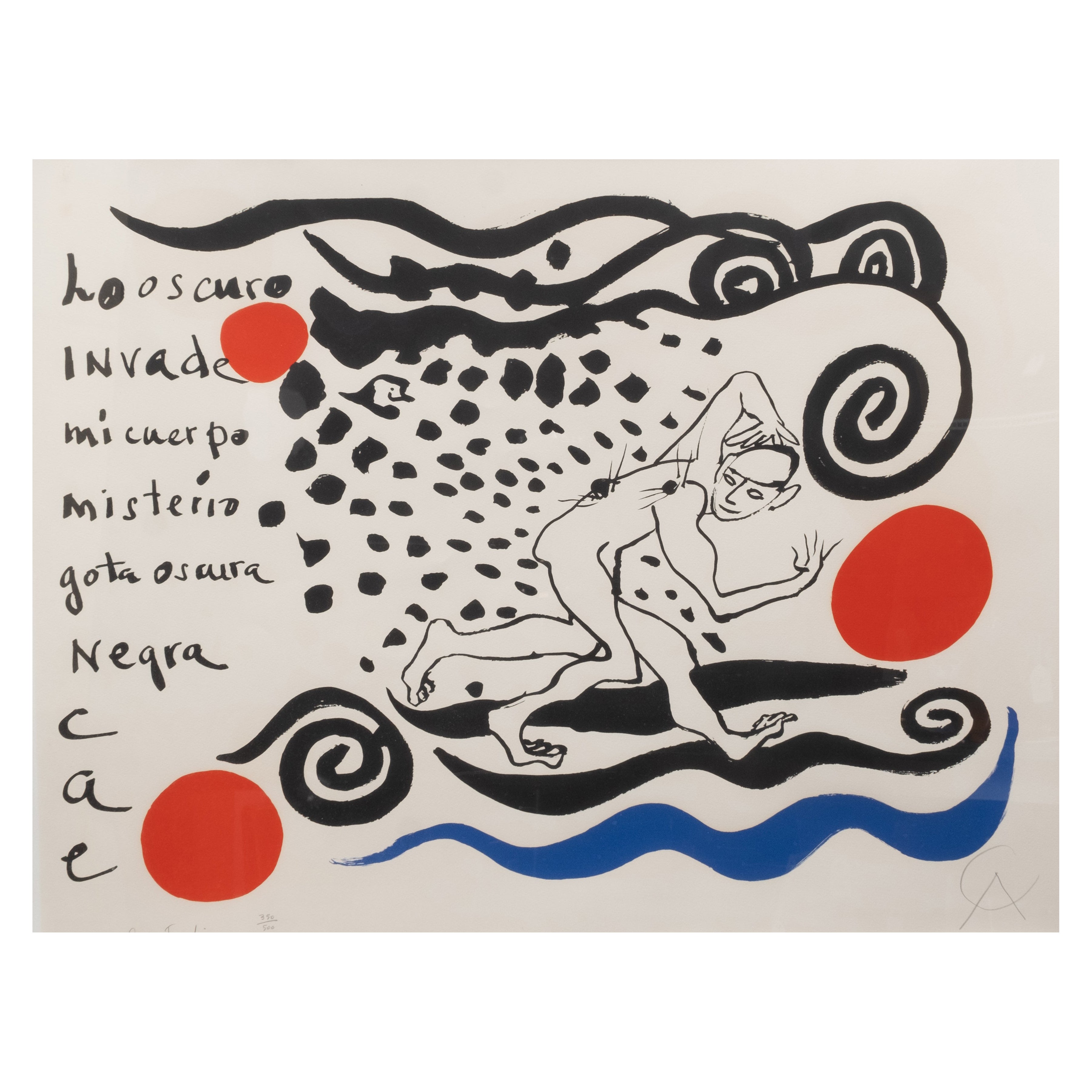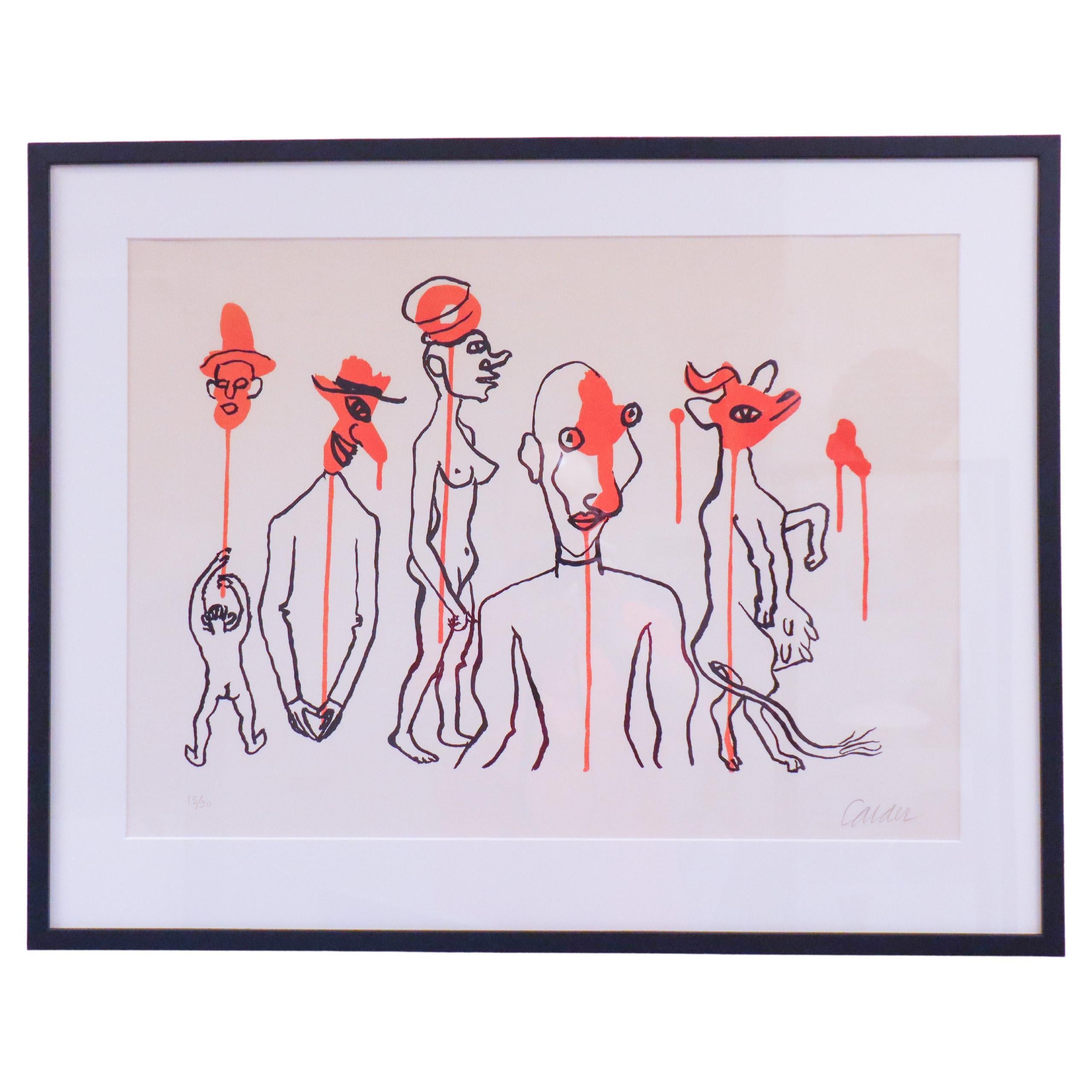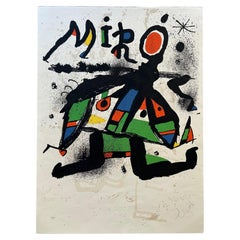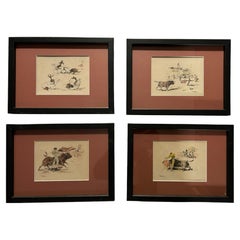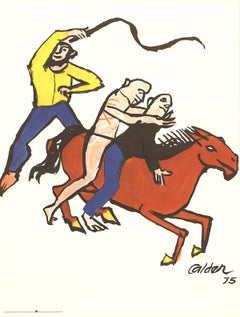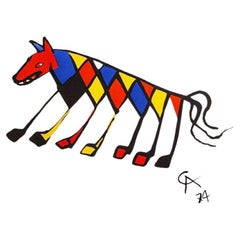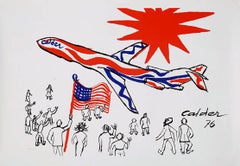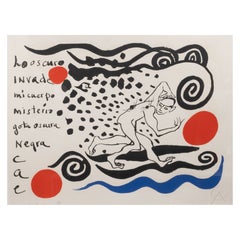Items Similar to Flight from Tyranny: for Amnesty International, 1975 Alexander Calder
Want more images or videos?
Request additional images or videos from the seller
1 of 6
Flight from Tyranny: for Amnesty International, 1975 Alexander Calder
$9,867.03
£7,200
€8,399.97
CA$13,515.36
A$15,032.03
CHF 7,849.26
MX$182,923.86
NOK 100,247.04
SEK 94,014.04
DKK 62,692.19
Shipping
Retrieving quote...The 1stDibs Promise:
Authenticity Guarantee,
Money-Back Guarantee,
24-Hour Cancellation
About the Item
Flight from Tyranny: For Amnesty International, 1975 by Alexander Calder
Hand-signed, limited edition offset lithograph in colours on wove paper, H/C signed in pencil, and numbered 4/XXII
This lithograph was limited to 100 signed and numbered copies as well as 22 signed and numbered in the H/C (Hors Commerce) edition. (There was also an unsigned general print run). Hors Commerce edition prints are usually only available directly from the artist. A Hors Commerce edition is given as a gift to the Artist. Of all the special prints of an image, the HC edition prints are the most valuable, because of their rarity.
Alexander Calder (1898 – 1976) Alexander Calder was born in 1898, the second child of artist parents, his father was a sculptor and his mother a painter. (His grandfather was Alexander Milne Calder.)
Despite showing artistic talents at an early age, Calder did not originally set out to become an artist. He instead enrolled at the Stevens Institute of Technology after high school and graduated in 1919 with an engineering degree. Having worked for several years after graduation at various jobs, Calder committed to becoming an artist and in 1923 he enrolled at the Art Students League, New York to launch his career as an artist.
Calder soon began to sculpt from wire many portraits of his friends and public figures of the day. Word travelled about the inventive artist, and in 1928 Calder was given his first solo gallery show at the Weyhe Gallery in New York. This exhibition was soon followed by others in New York, Paris, and Berlin.
He married Louisa James (a grandniece of writer Henry James) in January 1931. He also became friendly with many prominent artists and
intellectuals of the early twentieth century at this time in Paris, including Joan Miró, Fernand Léger, James Johnson Sweeney, and Marcel Duchamp.
In October of 1930, Calder visited the studio of Piet Mondrian in Paris and was deeply impressed by a wall of coloured cardboard rectangles that Mondrian continually repositioned for compositional experiments. For two weeks following this visit, he created solely abstract paintings, only to discover that he did indeed prefer sculpture to painting. Soon after, he was invited to join Abstraction-Création, an influential group of
artists, including Jean Arp, Mondrian, and Jean Hélion with whom he had become friendly.
In 1931, Calder created first truly Kinetic sculpture and gave form to an entirely new type of art. Many of these early objects moved by motors and were dubbed “mobiles” by Marcel Duchamp. Calder soon abandoned the mechanical aspects of these works when he realized he could fashion mobiles that would undulate on their own with the air’s currents. Arp, in order to differentiate Calder’s non-Kinetic works from his Kinetic works,
named Calder’s stationary objects “stabiles”.
In 1933, Calder and Louisa left France and returned to the United States, where they purchased an old farmhouse in Roxbury, Connecticut. Calder converted an icehouse attached to the main house into a studio. Because metal was in short supply duringthe war years, Calder turned increasingly to wood as a sculptural medium. Working in wood resulted in yet another original form of sculpture, works called “Constellations” by Sweeney and Duchamp. With their carved wood elements anchored by wire, the Constellations were so-called because they suggested the cosmos, though Calder did not intend that they represent anything in particular.
His first American gallery, The Pierre Matisse Gallery held an exhibition of these works in the spring of 1943, Calder’s last solo show at that gallery. His association with Matisse ended shortly thereafter, and he took up with the Buchholz Gallery/Curt Valentin as his New York representation.
The forties and fifties were a remarkably productive period for Calder, which was launched in 1938 with the first retrospective of his work at the George Walter Vincent Smith Gallery in Springfield, Massachusetts. A second, major retrospective was exhibited at the Museum of Modern Art in New York just a few years later, in 1943. In keeping with his economy, Calder made a series of small-scale works in 1945 primarily from
scraps of metal trimmed while making larger pieces.
In 1949, Calder constructed his largest mobile to date, International Mobile, for the Philadelphia Museum of Art’s Third International Exhibition of Sculpture. Galerie Maeght in Paris also held a Calder show in 1950 and subsequently became Calder’s exclusive Parisian dealer. His
association with Galerie Maeght lasted twenty-six years, until his death in 1976. After his New York dealer Curt Valentin died unexpectedly in
1954, Calder selected Perls Galleries in New York as his new American dealer, and this alliance also lasted until the end of his life.
Calder’s artistic talents were renowned worldwide by the 1960s by the range and breadth of his various projects and commissions.
Reflecting the tenets of Futurism, Constructivism and early non-objective painting, Alexander Calder changed the course of modern art with his three-dimensional Kinetic sculptures, ‘the mobiles’, which Calder’s consist of boldly coloured abstract shapes, which are made from Industrial materials and hang in lyrical balance.
Calder is best known for these visually fascinating and emotionally engaging, along with his monumental outdoor bolted sheet metal stabiles, which only imply movement and is one of the most-recognizable and beloved modern artists.
He also made a smaller number of sculptures in the more-traditional materials of wood and bronze and did paintings, mostly in gouache as well as drawings, including illustrations for books, and prints, and was also an inventive designer of jewellery.
Calder was an international phenomenon during his lifetime. He won the grand prize for sculpture at the 1952 Venice Biennale, where he represented the United States. He earned the French Legion of Honour and the American Presidential Medal of Freedom, among other honours.
Calder has been the subject of solo exhibitions at the Museum of Modern Art, the Rijksmuseum, the Louisiana Museum of Modern Art and the Museo Reine Sofia.
His work regularly sells for eight figures on the secondary market.
- Dimensions:Height: 30.32 in (77 cm)Width: 22.84 in (58 cm)Depth: 0.4 in (1 cm)
- Style:Mid-Century Modern (Of the Period)
- Materials and Techniques:
- Place of Origin:
- Period:
- Date of Manufacture:1975
- Condition:
- Seller Location:Pewsey, GB
- Reference Number:1stDibs: LU7343233492482
About the Seller
No Reviews Yet
Vetted Professional Seller
Every seller passes strict standards for authenticity and reliability
1stDibs seller since 2022
9 sales on 1stDibs
- ShippingRetrieving quote...Shipping from: Marlborough, United Kingdom
- Return Policy
Authenticity Guarantee
In the unlikely event there’s an issue with an item’s authenticity, contact us within 1 year for a full refund. DetailsMoney-Back Guarantee
If your item is not as described, is damaged in transit, or does not arrive, contact us within 7 days for a full refund. Details24-Hour Cancellation
You have a 24-hour grace period in which to reconsider your purchase, with no questions asked.Vetted Professional Sellers
Our world-class sellers must adhere to strict standards for service and quality, maintaining the integrity of our listings.Price-Match Guarantee
If you find that a seller listed the same item for a lower price elsewhere, we’ll match it.Trusted Global Delivery
Our best-in-class carrier network provides specialized shipping options worldwide, including custom delivery.More From This Seller
View AllJoan Miro Signed Lithograph
Located in Pewsey, GB
Poster for Joan Miro Exhibition at Galerie Maeght
Lithograph printed in colours for an exhibition of Miro's work in Paris from November 1978 to January 1979 signed in pencil from an edition of 75.
This one numbered 37/75 on wove paper
Printed by Arte Adrien Maeght, Paris in 1978 and Published by Maeght Editeur, Paris
Full sheet printed to the edges with Dimensions: 78.1 x 57.2 cm
Condition: Very Good
Joan Miro I Ferra (20 April 1893 – 25Decemer 1983) known in the art world as Joan Miro was a Spanish painter, sculptor and ceramicist born in Barcelona into a family of a goldsmith and a watchmaker in the Barri Gotic neighbourhood. He studied at the Cerce Artistic de Sant Lluc and had his first solo show in 1918 at the Galeries Dalmau, where his work was ridiculed and defaced. Inspired by Fauve and Cubist exhibitions in Barcelona and abroad, Miro was drawn towards the arts community that was gathering in Montparnasse and moved to Paris in 1920, but continued to spend his Summers in his native Catalonia.
In Paris, under the influence of poets and writers, he developed his unique style: organic forms and flattened picture-planes drawn with a sharp line. Generally thought of as a Surrealist because of his interest in automatism and the use of sexual symbols, Miro’s style...
Category
Late 20th Century French Modern Posters
Materials
Paper
Olympic Games Munich 1972 Limited Edition Signed by Artist Jacob Lawrence
Located in Pewsey, GB
Rare Olympic Games Munich 1972 Limited Edition 'Poster entitled 'Five Black Athletes in a Relay
Race' signed and numbered by Jacob Lawrence
Dimensions:
Sheet Size: Length 109.5 × 69.5 cm
Image Size: Length: 87 × 64 cm
Edition Size: 200
Edition Number: 24 marked in pencil by Jacob Lawrence
Signed: Jacob Lawrence 71 in pencil by Jacob Lawrence
Serigraph – Screenprint
Printed words on the left hand corner of the sheet read as follows:
© Edition Olympia 1972 Gmbh 1971
Dietz Officin Lengmoos
Description
Bold colours fresh and vibrant as when originally issued
Overall condition: Very good for age
A minor tear at the top edge has been repaired and the poster has been given a conservation wash by one of UK’s leading paper conservators, in the main, to remove soluble pollutants, which if left untreated in a poster, in particular, one printed more than 50 years ago would accelerate its degradation. This first class conservational treatment will ensure that the poster would retain its present condition if professionally framed with museum-quality glass and not
exposed to direct sunlight or put into long-term storage following the specialist guidelines for the storage of posters and prints.
Jacob Lawrence was one of a number of artists who were invited to design posters for the 1972 Olympic Games held in Munich. He was first non-white artist to commissioned by an Olympic Games Committee.
Lawrence created an image to commemorate the involvement of black athletes in the Olympic Games, as track was the field in which they had traditionally excelled.
This striking poster depicts five black runners with grimacing faces take giant strides around a large, curving track as they head toward the finish line.
They hold batons in their hands to show that they are competing in a relay race.
Each athlete is shown with his arms, legs, and head in a slightly different position, one has his head back and his right leg stretched forward, almost straight.
Lawrence used bold colours to depict the runners' stylised faces and legs as well as the repeated shapes of the track.
He combined the flat, simplified shapes and empty spaces of modernism with silhouetted figures and the rhythmic patterns and colours of Harlem scenes. He labelled his pictorial style 'dynamic cubism'.
Lawrence's poster embraces several themes:
a) the intensity of competition in a relay race with invariably dramatic endings;
b) memories of the African American athlete, Jesse Owens...
Category
Vintage 1970s American Mid-Century Modern Posters
Materials
Paper
Munich 1972 Olympic Games Ltd Edition 'Spirale' Emblem Official Poster Signed
Located in Pewsey, GB
Rare Munich 1972 Olympic Games Limited Edition 'Spirale' Emblem Official Poster designed by Otl Aicher, Coordt von Mannstein and Victor Vasarely and signed...
Category
Vintage 1970s German Modern Posters
Materials
Paper
Joaquim Terruella Matilla - Coloured Etchings (4) - Bullfighting
Located in Pewsey, GB
A Fabulous set of Hand Coloured Etching by Joaquim Terruella Matilla (1891-1957) of Bullfighting
Nephew and follower of Segundo Matilla, Joaquín Terruella was also a disciple of Sa...
Category
Vintage 1940s Spanish Mid-Century Modern Paintings
Materials
Paint
$871 Sale Price
36% Off
Heinz Henghes - Nude Etching - Numbered 6/10 - Signed and Dated 1970
Located in Pewsey, GB
Heinz Henghes - Nude Etching - Numbered 6/10 - Signed and Dated 1970 - Image Size 25 x 20 cm
Heinz Henghes was born in Hamburg in 1906. Died in 1975 .
At an early age he went to Ame...
Category
Vintage 1970s British Modern Prints
Materials
Paper
Iconic 1971 Large Original Framed Poster 'Bullfighting Alacete, Spain'
Located in Pewsey, GB
An Iconic Original Bullfighting Large Poster (September Month 1971) that has been beautifully framed for the The Plaza de Toros de Albacete a bullring in the town of the Albacete, in...
Category
Vintage 1970s Spanish Mid-Century Modern Posters
Materials
Paper
You May Also Like
After Alexander Calder-Amnesty International-
By Alexander Calder
Located in Brooklyn, NY
First edition advertising poster by Alexander Calder for Amnesty International in 1977.
Artists for Amnesty, a series of art posters created by ...
Category
20th Century Contemporary Prints and Multiples
Materials
Offset
$344 Sale Price
23% Off
1970s Original Astonishing Alexander Calder "Beastie" Lithograph
By Alexander Calder
Located in Milano, IT
1970s Original Astonishing Alexander Calder Litograph called "Beastie" Limited Edition (1974 Braniff Airlines) Signed in Plate.
This lithograph is in excellent condition, initialed a...
Category
Vintage 1970s Italian Mid-Century Modern Prints
Materials
Paper
1970s Alexander Calder poster (Calder Braniff Airlines 1976)
By Alexander Calder
Located in NEW YORK, NY
Alexander Calder Braniff Airlines poster 1976:
Medium: Offset lithograph.
Dimensions: 23 x 33 inches.
Signed in plate
An original 1st printing in very good overall vintage conditio...
Category
1970s Pop Art Figurative Prints
Materials
Offset
$650 Sale Price
21% Off
Alexander Calder and Carlos Franqui Large Format Limited Edition Lithograph
By Alexander Calder
Located in Kingston, NY
Pencil signed by both Alexander Calder (Lower Right,) and the poet Carlos Franqui (Lower Left) and 1970. Numbered 350/500 Color lithograph, 1970. 610x820 mm; 24x32 1/4 inches, full m...
Category
20th Century Prints
Materials
Paper
Alexander Calder, Original Lithograph 15/90, Les Queles Deqoulinantes 1966
By Alexander Calder
Located in Stockholm, SE
A lithograph by Alexander Calder namned Les Queles Deqoulinantes. This is number 15 in an edition of 90. It is 76 x 59 cm (framed), 61 x 44 cm (picture). It is reframed but have the ...
Category
Vintage 1960s French Modern Prints
Materials
Paper
Alexander Calder Lithographs
By (after) Alexander Calder
Located in Atlanta, GA
Selection of Alexander Calder color lithographs, France, circa 1960s. We purchased a group of these color lithographs from the estate of a coup...
Category
Vintage 1960s French Mid-Century Modern Prints
Materials
Glass, Wood, Paper
$750 / item
More Ways To Browse
Large Outdoor Wall Art
Alexander Calder Edition
Joan Miro Hc
Totoro Poster
Vintage Bruce Lee Movie Posters
Vintage Poster Peru
West Side Story Poster
Wimbledon Poster
Alice In Wonderland Poster Vintage
Art Deco Jazz Poster
Bullitt Movie Poster
Bus Roll
Canadian Pacific Vintage Travel Posters
Cappiello Mossant
Charlton Heston
Cinzano Poster Vintage
Easy Rider Poster
For Your Eyes Only Poster
